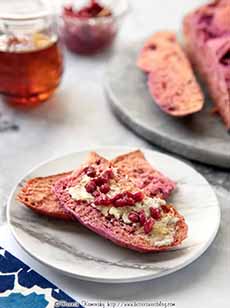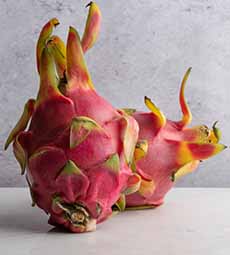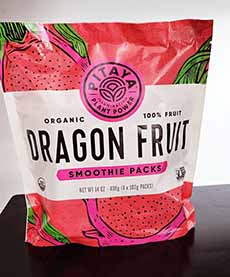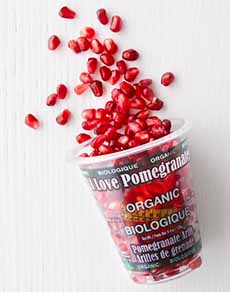Pink Challah Recipe With Dragon Fruit & Pomegranate Arils
|
|
No, this isn’t Barbie bread. It’s a pink challah, created by our colleague Hannah Kaminsky for Rosh Hashanah, the Jewish new year, which begins at sundown on Friday, September 15th*. Holiday notwithstanding, any lover of delicious bread can bake a loaf or two or more (challah freezes very well) at any time of the year. Challah, pink or otherwise, is a soft, subtly sweet loaf that works as well with dinner as it does for breakfast. It also makes delicious bread pudding, breakfast casseroles, croutons, French toast, stuffing, tea sandwiches, and other sandwiches (the recipe below is especially good for PB&J and grilled cheese sandwiches with brie and strawberries). Among the traditional Rosh Hashanah foods†, apple slices dipped in honey are served to ensure a sweet new year ahead. But pomegranates also hold special significance, representing abundance and fertility. “This year,” says Hannah, “multiply your mitzvot [blessings] with pink pomegranate challah, a brilliant-colored round loaf with crunchy pomegranate arils in every slice.” The round challah in this recipe is often interpreted as a representation of the cyclical nature of life and the continuity of creation. The circular shape is also seen as a symbol of unity and completeness, as there is no beginning or end to a circle. So think pink: Start a new tradition for Rosh Hashanah with pink pomegranate challah, as rich with symbolism as it is with color and flavor. For more on dragon fruit (pitaya), see below. This challah is naturally colored pink with dragon fruit (pitaya) purée. You can find frozen dragon fruit smoothie packs (which is puréed fruit) in a well-stocked supermarket or health food store, as well as at superstores like Costco and Target. Prep time is 30 minutes, cook time is 30 minutes, and rising time is 1-1/2 to 2 hours. Total time is 2-1/2 to 3 hours. 1. USING a stand mixer, combine the yeast with the warm water and the sugar in the bowl. Let stand for 5-10 minutes, until the mixture becomes lightly frothy. Then add the honey or agave, dragon fruit purée, and oil, stirring lightly to combine. 2. MIX together 3 cups of flour with the salt and add it to the bowl of wet ingredients. Install the dough hook, and begin mixing on low speed. Pause to scrape down the sides of the bowl as needed to get all ingredients incorporated. It may take a few minutes, but be patient! 3. CONTINUE mixing with the dough hook, allowing it to knead for 8-10 minutes. It should become smooth as elastic, remaining a bit tacky but not downright sticky. Incorporate additional flour as needed. 4. TRANSFER the dough to a lightly greased bowl and cover with a kitchen towel or plastic wrap. Let it rise in a warm place for 1-1/2 to 2 hours, until roughly doubled in volume. 5. PUNCH down the dough, cut it into four equal pieces, then roll each piece into long, smooth strands on a lightly floured work surface. It does tend to get a bit sticky, so don’t be afraid to add more flour as needed. The exact length isn’t as important as the fact that they match in size, though aim for somewhere around 1 to 1-1/2 feet long. 6. USE a rolling pin to flatten out the logs into think ovals. Sprinkle about 2 tablespoons of the pomegranate arils down the center of each one, folding over the sides and pinching the edges to seal them within. 7. BRAIDING: You can either simply spiral the strands together into a round, or braid them starting in the center, then fold under the ends. Hannah’s best advice for shaping is to consult a YouTube video, because “I have a very hard time describing the process and I’m certainly no master of it myself!” Once braided… 8. GENTLY TRANSFER the loaf onto a sheet pan lined with parchment paper or a silicone baking mat. Brush generously with the beaten egg yolk to cover the entire exposed surface. 9. PREHEAT the oven to 400°F allowing the bread to rise for at least 30 minutes while it comes up to temperature. Immediately reduce the temperature to 375°F once you slide the dough into the center of the oven. Bake for 30-35 minutes, until the top is gently golden all over. 10. COOL on a rack until at room temperature before cutting into generous slices. Dragon fruit (also called pitaya and pitahaya) is a the fruit of a climbing cactus, Hylocereus undatus, which is native to Central and South America and requires a warm, humid climate. The cactus produces large, fragrant flowers that bloom at night and are pollinated by nocturnal creatures like bats and moths. |
|
|
The pollinated flowers develop into the colorful, spiky-skinned dragon fruit. Different varieties have pink or yellow outer skin with pink, red, or white flesh dotted with tiny black seeds. Cultivated by the Mayas and Aztecs, dragon fruit was later introduced to Southeast Asia, the U.S., and other parts of the world. Around the 16th century, the fruit was found by European missionaries and explorers traveling in Central America. From there it was transported to all corners of the globe [source]. The French introduced the fruit into Vietnam more than a century ago, and Vietnam is the world’s leading exporter of dragon fruit. Other countries such as Australia, the Caribbean, China, Israel, Malaysia, the Philippines, Taiwan, Thailand, and the U.S. (Florida and Hawaii) are some other countries that grow the fruit [source]. Its taste is often described as a blend of kiwi, pear, and watermelon, with a mildly sweet and refreshing flavor (personally, we find it bland). The fruit is packed with essential nutrients, including vitamins C and E, antioxidants, and dietary fiber. It’s low in calories and high in water content. The fruit is commonly used in fruit salads and smoothies, but it can also be eaten raw or grilled. It became is a popular ingredient in many Asian and Latin American cuisines, both savory and sweet. It is also served as a juice and made into sorbet and syrup. The unopened flower buds can be cooked like vegetables. Its high price is due to its labor-intensive cultivation and harvesting and its delicate skin and perishable nature. *The dates change every year according to the Jewish calendar. It’s the first of the Jewish High Holy Days, as specified by Leviticus 23:23–25. Here’s more about it. †Traditional Rosh Hashanah foods include, among others, apple cake, apples and honey, brisket, challah, gefilte fish, honey cake, kasha varnishkes, kugel, matzoh ball soup, and tzimmes. CHECK OUT WHAT’S HAPPENING ON OUR HOME PAGE, THENIBBLE.COM.
|
||








